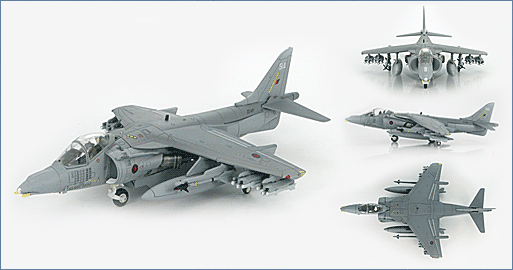Air Power Series>1:72 die-cast display model>Harrier>HA2604
GR.9A Harrier II RAF/Royal Navy Joint Force Harrier, Operation Herrick, Afghanistan 2008

General Background
The Harrier is the first operational V/STOL (Vertical/Short Takeoff and Landing) aircraft. By directing the engines exhaust through movable nozzles the force could be used to propel the aircraft along a runway or lift it vertically and then into a forward motion. Because of this ability to lift off vertically the Harriers began to be referred to as “jump jets”. These aircraft were continuously being refined and improved over the years with many new variants being produced.
The Aircraft
When the conflict in Afghanistan escalated during 2004, the Harrier’s role as a first class air support jet was increasingly relied upon to help troops on the ground against Taleban forces. Several times, the Harrier’s commitment to Operation Herrick was extended and eventually their stay lasted nearly 5 years. During this time Joint Force Harrier accomplished a total of 8,557 sorties and 22,771 flying hours on Close Air Support and tactical reconnaissance missions in support of NATO and Coalition ground forces. Joint Force Harrier has been engaged in Afghanistan during the longest period of high tempo ops involving UK air power since World War II.
Specifications :
| Crew: | 1 |
| Dimensions | |
| Length: | 46 ft 4 in (14.12 m) |
| Height: | 11 ft 8 in (3.56 m) |
| Wingspan: | 30 ft 4 in (9.25 m) |
| Wing area | 343 ft² (22.6 m²) |
| Weights | |
| Empty: | 12,500 lb (5,700 kg) |
| Loaded: | 15,703 lb (7,123 kg) |
| Maximum Takeoff : | VTO 18,950 lb (8,595 kg) |
| STO 31,000 lb (14,016 kg | |
| Powerplant | |
| Engines: | 1× Rolls-Royce Pegasus Mk. 105 turbofan with four thrust vectored exhaust nozzles, 21,750 lb (96.7 kN) |
| Performance | |
| Maximum speed: | 662 mph (1,065 km/h) |
| Combat radius: | 300 nmi (556 km) |
| Ferry range: | 2,015 mi ( 3,242.8 km ) |
| Service ceiling: | 50,000 ft (15,000 m) |
| Rate of climb: | 14,715 ft/min (74.8 m/s) |
| Armament | |
| Guns | 2 × 30 mm (1.18 in) ADEN cannon pods under the fuselage |
| Hardpoints | 8× under-wing pylon stations holding up to 8,000 lb (3,650 kg) of payload |

